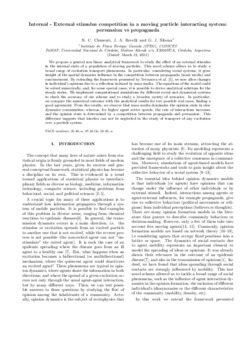| dc.contributor.author | Clementi, Natalia Carolina | |
| dc.contributor.author | Revelli, Jorge Alberto | |
| dc.contributor.author | Sibona, Gustavo Javier | |
| dc.date.accessioned | 2022-04-05T18:31:04Z | |
| dc.date.available | 2022-04-05T18:31:04Z | |
| dc.date.issued | 2015 | |
| dc.identifier.citation | De ésta versión: Clementi, Natalia Carolina; Revelli, Jorge Alberto; Sibona, Gustavo Javier; Internal-external stimulus competition in a system of interacting moving particles: Persuasion versus propaganda; American Physical Society; Physical Review E: Statistical, Nonlinear and Soft Matter Physics; 92; 1; 7-2015 [Versión aceptada] http://hdl.handle.net/11086/23649 | es |
| dc.identifier.uri | http://hdl.handle.net/11086/23649 | |
| dc.identifier.uri | De la versión publicada: https://doi.org/10.1103/PhysRevE.92.012816 | |
| dc.description.abstract | We propose a general nonlinear analytical framework to study the effect of an external stimulus in the internal state of a population of moving particles. This novel scheme allows us to study a broad range of excitation transport phenomena. In particular, considering social systems, it gives insight of the spatial dynamics influence in the competition between propaganda (mass media) and convincement. By extending the framework presented by Terranova et al. [Europhys. Lett. 105, 30007 (2014)], we now allow changes in individual´s opinions due to a reflection induced by mass media. The equations of the model could be solved numerically, and, for some special cases, it is possible to derive analytical solutions for the steady states. We implement computational simulations for different social and dynamical systems to check the accuracy of our scheme and to study a broader variety of scenarios. In particular, we compare the numerical outcome with the analytical results for two possible real cases, finding a good agreement. From the results, we observe that mass media dominates the opinion state in slow dynamics communities; whereas, for higher agent active speeds, the rate of interactions increases and the opinion state is determined by a competition between propaganda and persuasion. This difference suggests that kinetics can not be neglected in the study of transport of any excitation over a particle system. | es |
| dc.language.iso | eng | es |
| dc.rights | Attribution-NonCommercial-NoDerivatives 4.0 International | * |
| dc.rights.uri | http://creativecommons.org/licenses/by-nc-nd/4.0/ | * |
| dc.source | ISSN: 1063-651X | |
| dc.subject | Stochastic | en |
| dc.subject | Process | en |
| dc.subject | Sociophysics | en |
| dc.title | Internal - External stimulus competition in a system of interacting moving particles : persuasion vs propaganda | en |
| dc.type | article | es |
| dc.description.version | acceptedVersion | es |
| dc.description.fil | Fil: Clementi, Natalia Carolina. Consejo Nacional de Investigaciones Científicas y Técnicas. Instituto de Física Enrique Gaviola; Argentina | es |
| dc.description.fil | Fil: Revelli, Jorge Alberto. Consejo Nacional de Investigaciones Científicas y Técnicas. Instituto de Física Enrique Gaviola; Argentina | es |
| dc.description.fil | Fil: Sibona, Gustavo Javier. Consejo Nacional de Investigaciones Científicas y Técnicas. Instituto de Física Enrique Gaviola; Argentina | es |
| dc.journal.country | Estados Unidos | es |
| dc.journal.editorial | ELSEVIER | es |
| dc.journal.pagination | 1-9 | es |
| dc.journal.referato | Con referato | |
| dc.journal.title | PHYSICAL REVIEW E - STATISTICAL PHYSICS, PLASMAS, FLUIDS AND RELATED INTERDISCIPLINARY TOPICS | en |
| dc.journal.volume | 92 | es |
| dc.description.field | Otras Ciencias Físicas | |





